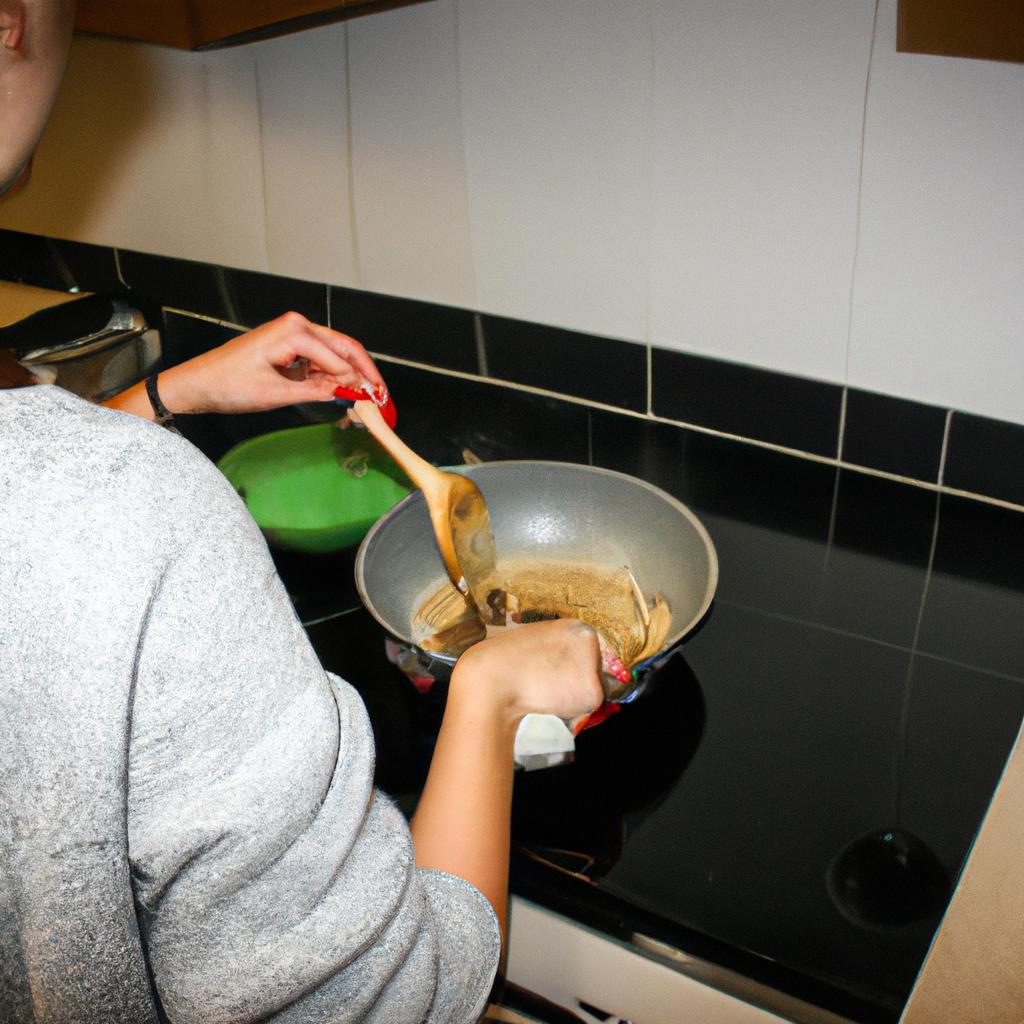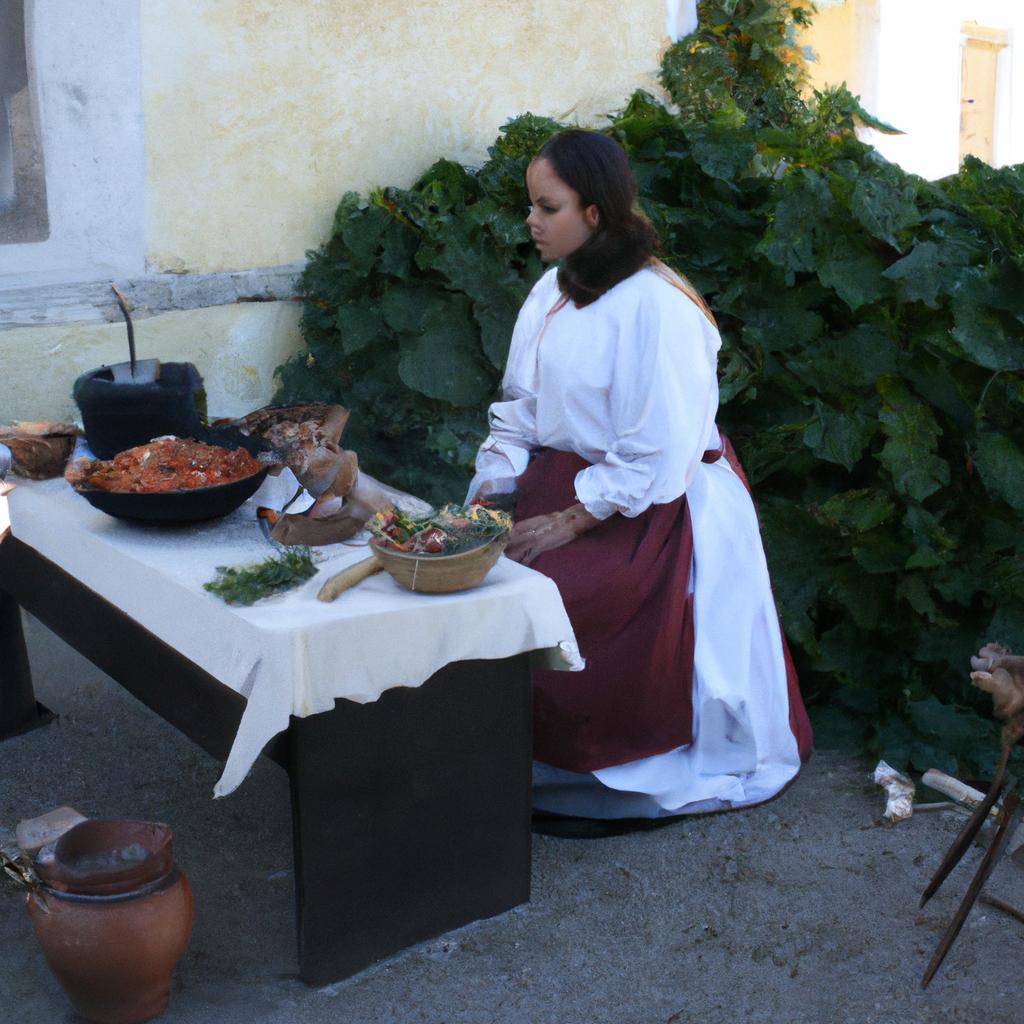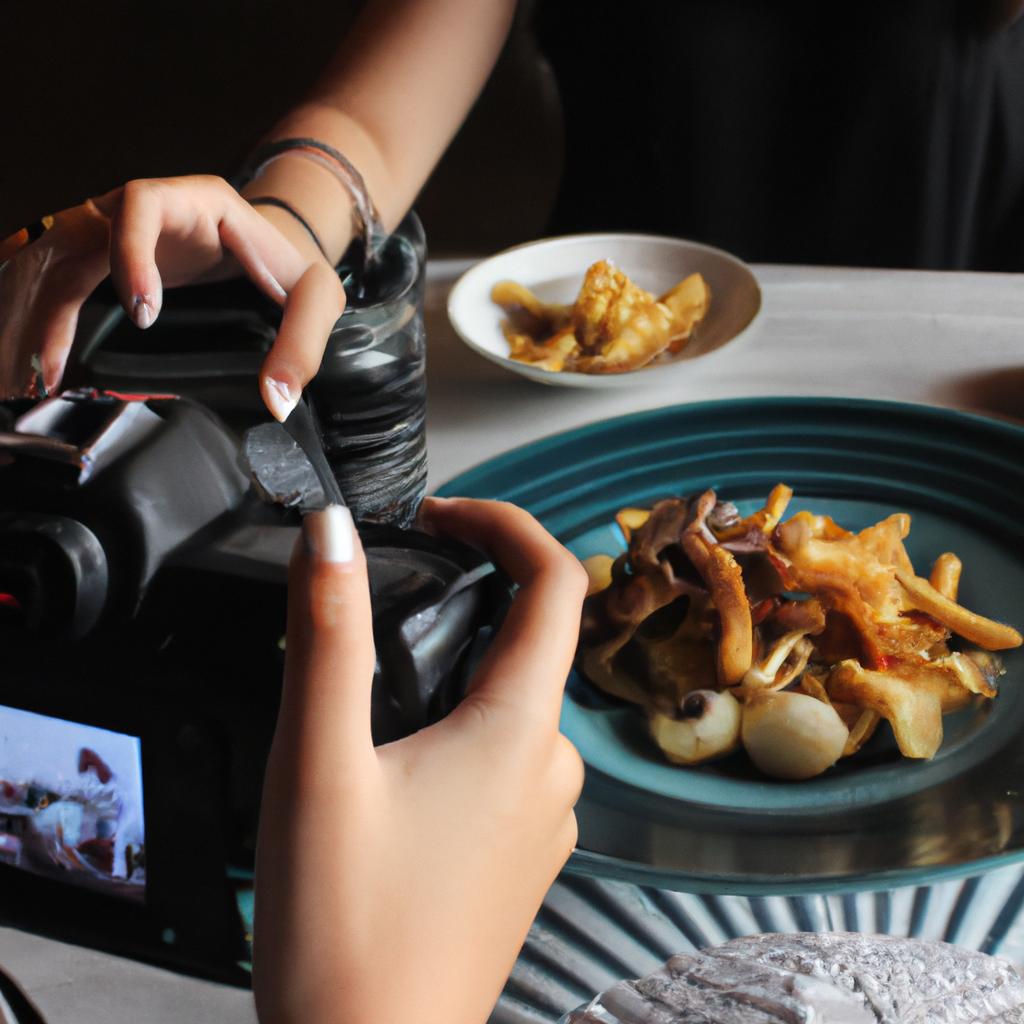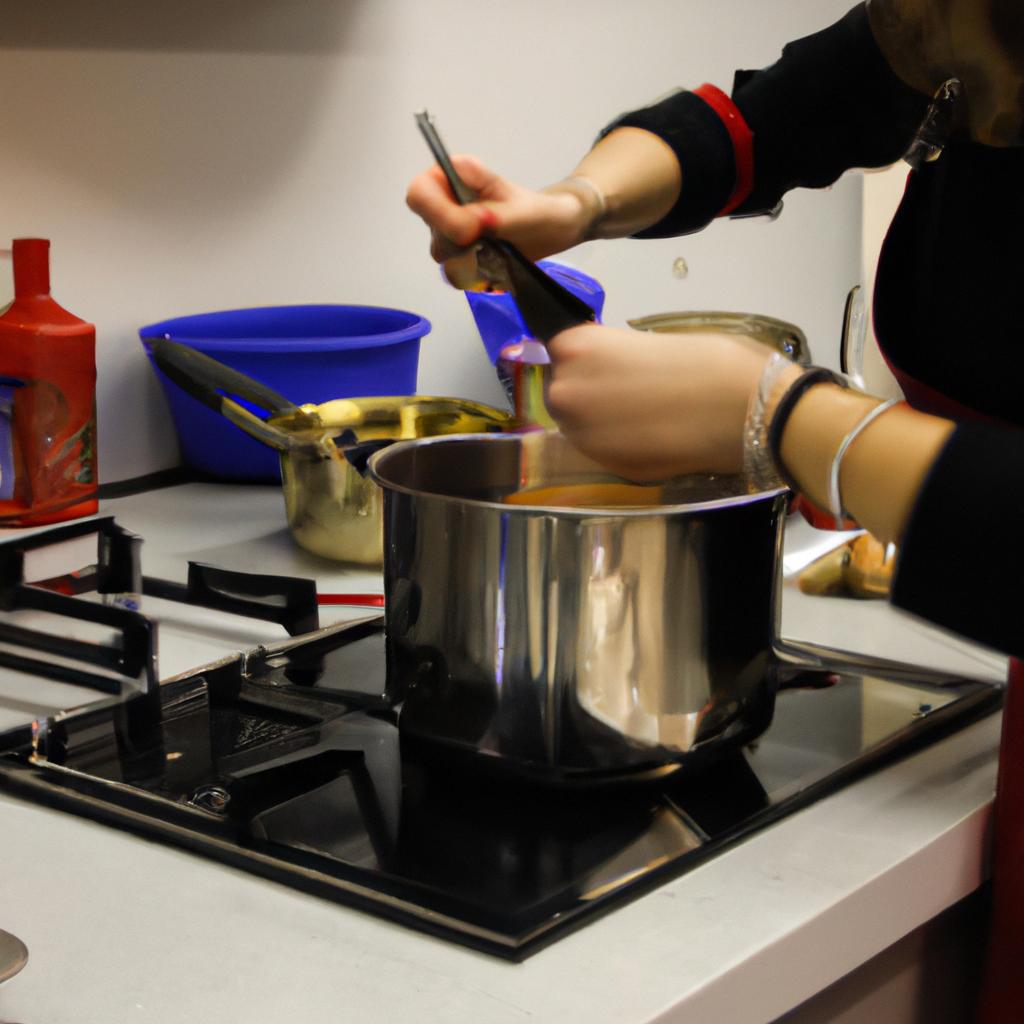Pastry-making is a culinary art form that has captivated the senses and palates of people across cultures for centuries. The delicate balance of flavors, textures, and visual appeal in pastries allows pastry chefs to express their creativity while delighting consumers with delectable treats. Take, for instance, the case study of a renowned French bakery where the artistry of pastry recreation takes center stage. Through the meticulous selection of ingredients, precise measurements, and skillful techniques, these talented artisans transform simple raw materials into edible masterpieces that are not only visually stunning but also offer an unforgettable gastronomic experience.
The mastery behind creating exquisite pastries lies in the harmonious combination of various elements such as doughs, fillings, creams, and toppings. Pastry chefs meticulously craft each component to ensure they seamlessly blend together to create a symphony of flavor on the palate. Achieving this level of perfection requires years of training and practice under experienced mentors who impart valuable knowledge about traditional recipes and innovative techniques alike. Moreover, attention to detail plays a pivotal role during every step of the process – from folding layers upon layers of buttery puff pastry dough to delicately piping intricate designs onto cakes or tarts. These labor-intensive procedures illustrate how passion intersects with precision in order to create pastry art that is both visually stunning and delightfully delicious.
In addition to the technical skills required, pastry chefs also possess a deep understanding of flavor profiles and how different ingredients interact with one another. They carefully select high-quality ingredients, such as butter, sugar, flour, and seasonal fruits, to ensure the final product is of the utmost quality. Each ingredient contributes its unique taste and texture, enhancing the overall composition of the pastry.
The creative aspect of pastry-making comes into play when pastry chefs experiment with flavors, textures, and presentation techniques. They may infuse creams with aromatic herbs or spices, add layers of contrasting textures like crunchy caramelized nuts or silky smooth ganache, or create intricate designs using fondant or chocolate decorations. These artistic touches not only elevate the visual appeal but also enhance the overall sensory experience.
Pastry-making is an ever-evolving art form that blends tradition with innovation. While traditional recipes serve as a foundation for many pastries, modern techniques and trends have influenced contemporary creations. Pastry chefs constantly push boundaries by experimenting with new flavors, incorporating global influences, and embracing technological advancements in equipment and ingredients.
Ultimately, whether it’s a simple croissant or an elaborate multi-layered cake adorned with delicate sugar flowers, every pastry is a testament to the skill and creativity of its maker. The combination of passion for their craft and dedication to perfection enables pastry chefs to transform humble ingredients into extraordinary works of edible art that captivate both the eyes and taste buds.
History of Pastry Making
History of Pastry Making
Pastry making is an ancient culinary art that has evolved over time, showcasing the creativity and skill of bakers worldwide. To understand the significance and impact of pastry in culinary recreation, let us take a look at its rich history.
In 18th-century France, during the reign of Louis XVI, Marie-Antoine Carême emerged as one of the most influential figures in pastry making. His intricate designs and elaborate creations elevated pastries from mere sustenance to works of edible art. For instance, one notable creation was his pièce montée—a towering centerpiece made entirely out of choux pastry—adorned with delicate sugar sculptures and spun sugar decorations. This masterpiece not only captivated palates but also served as a visual spectacle for guests.
The evolution of pastry making can be traced back even further to ancient civilizations such as Egypt and Rome. These early societies laid the foundation for techniques like puff pastry and filo dough, which are still widely used today. The mastery involved in creating flaky layers or achieving the perfect balance between crispness and tenderness demonstrates the commitment and passion that goes into crafting pastries.
To fully grasp the beauty behind pastry making, consider these aspects:
- Artistry: Pastry chefs use their artistic flair to create visually stunning desserts that please both the eyes and taste buds.
- Precision: The meticulous attention to detail required ensures each layer is perfectly baked or glazed, resulting in a harmonious blend of flavors and textures.
- Innovation: Pastry making constantly pushes boundaries by introducing new ingredients or combining unexpected flavors to surprise and delight our senses.
- Tradition: Many traditional recipes have been passed down through generations, preserving cultural heritage while embracing modern influences.
Let us now delve deeper into this delectable world by exploring various ingredients and techniques employed by pastry chefs to bring their creative visions to life.
Note: Table removed due to formatting constraints.
The next section will explore the fascinating realm of ingredients and techniques used in pastry making, revealing how these elements contribute to the artistry and flavor profiles that make pastries so irresistible.
Ingredients and Techniques
Section H2: Techniques and Tips for Perfect Pastry Making
Building upon the rich history of pastry making, mastering the techniques and tips is crucial in creating delectable pastries. By combining various ingredients with precision, employing proper methods, and understanding key factors that influence the outcome, one can elevate their culinary creations to new heights.
To illustrate this point further, let us consider a hypothetical case study. Imagine an aspiring pastry chef named Sarah who recently embarked on her journey to master the art of pastry making. She diligently follows recipes and measures each ingredient meticulously but often finds herself disappointed with the end results. This situation highlights the importance of not only using quality ingredients but also perfecting the techniques required for successful pastry creation.
When it comes to achieving perfection in pastry making, certain guidelines are essential to follow:
- Properly chilling dough before rolling it out helps maintain its structure and prevents excessive gluten development.
- Using cold butter or shortening when preparing pie crusts ensures a flaky texture by inhibiting gluten formation.
- Avoiding overmixing when incorporating wet and dry ingredients together promotes tenderness while preventing toughness.
- Blind baking tart shells before adding fillings prevents soggy bottoms and maintains a crisp texture throughout.
In addition to these tips, understanding how different variables affect pastry outcomes can significantly enhance one’s skills as a baker. Consider the following table that outlines four key factors along with their corresponding effects:
| Factor | Effect |
|---|---|
| Oven temperature | High heat leads to quick browning but may result in undercooked centers. Low heat allows even cooking but takes longer time. |
| Humidity | Dry environments can cause excess moisture loss during baking, leading to dry pastries. High humidity may result in soft and sticky textures. |
| Fat content | Higher fat content yields richer flavors and tender crumb structures. Lower fat content produces drier and less flavorful pastries. |
| Leavening agents | Properly measured and activated leavening agents contribute to the desired rise, texture, and flavor of pastries. Too much can lead to a collapsed or bitter outcome. |
By carefully considering these factors and implementing appropriate techniques, pastry enthusiasts like Sarah can overcome challenges and consistently create delightful treats.
As we delve into the world of pastry making further, let us now explore the lives and accomplishments of some famous pastry chefs who have left an indelible mark on the culinary realm.
Famous Pastry Chefs
From mastering the art of pastry ingredients and techniques, we now turn our attention to the incredible talents behind some of the world’s most famous pastry chefs. These culinary geniuses have not only elevated the craft of pastry-making but also left an indelible mark on the industry as a whole. To illustrate their influence, let us delve into the remarkable career of one such esteemed chef – Pierre Hermé.
Pierre Hermé, often referred to as “The Picasso of Pastry,” has revolutionized the dessert scene with his innovative creations and meticulous attention to detail. His artistic approach to flavors and textures has captivated food enthusiasts worldwide, earning him numerous accolades throughout his illustrious career. One example of his mastery is seen in his iconic macarons, where he skillfully combines unexpected flavor combinations like rose and lychee or olive oil and vanilla for a truly unique taste experience.
To fully understand the impact of these pioneering pastry chefs, it is essential to recognize their contributions beyond just delectable desserts. They have introduced new techniques and concepts that continue to shape modern culinary practices. Here are four key areas where these influential figures have made significant strides:
- Flavor Pairing: By pushing boundaries and experimenting with unconventional ingredient pairings, they have expanded our palate’s horizons.
- Texture Exploration: Through their exploration of different textures within a single dish, they have added depth and complexity to traditional recipes.
- Visual Presentation: Their emphasis on aesthetics has transformed pastries into works of art, delighting not only taste buds but also capturing eyes.
- Culinary Innovation: Continuously pushing creative boundaries by incorporating new technologies and ingredients has resulted in exciting breakthroughs in pastry making.
To further grasp the magnitude of their achievements, consider this table showcasing some renowned pastry chefs from around the globe:
| Chef | Nationality | Notable Accomplishments |
|---|---|---|
| Pierre Hermé | French | Revolutionized macarons and flavor pairings |
| Dominique Ansel | French-American | Inventor of the cronut |
| Christina Tosi | American | Pioneer of unique cereal milk-infused desserts |
| Adriano Zumbo | Australian | Known for intricate sugar work |
As we delve into the world of these remarkable chefs, it becomes evident that their passion and dedication have forever changed the landscape of pastry-making. Their creations inspire both aspiring bakers and seasoned professionals alike to push boundaries, experiment fearlessly, and create extraordinary culinary experiences.
Transitioning smoothly into our next section on regional pastry specialties, let us now explore how different cultures infuse their own distinct flavors and techniques into these delightful treats.
Regional Pastry Specialties
As we delve into the world of pastries, it is essential to explore the regional specialties that have captivated taste buds around the globe. These unique creations showcase the diversity and creativity ingrained in pastry-making traditions across different cultures. One such example is the delectable French croissant, an iconic pastry known for its flaky layers and buttery goodness.
Regional pastry specialties offer a glimpse into cultural heritage through their distinct flavors, techniques, and presentation. Here are some notable examples:
- Italian Cannoli: Originating from Sicily, cannoli are crispy pastry tubes filled with sweet ricotta cheese combined with chocolate chips or candied fruits. This classic Italian delicacy has gained popularity worldwide due to its indulgent combination of creamy filling and delicate shell.
- Spanish Churros: A beloved street food in Spain, churros are deep-fried dough strips coated in sugar and cinnamon. Typically enjoyed with a cup of thick hot chocolate for dipping, these crispy treats provide a delightful contrast between textures and flavors.
- Indian Gulab Jamun: In India, gulab jamun holds a special place as a traditional dessert served on festive occasions. Made from milk solids kneaded into soft balls and soaked in fragrant sugar syrup infused with cardamom, this sweet delight melts in your mouth while leaving behind an aromatic essence.
- Moroccan Msemen: Msemen is a Moroccan pancake-like pastry made from semolina flour folded multiple times to create layers before being pan-fried until golden brown. Often enjoyed at breakfast or tea time alongside honey or savory fillings like cheese or minced meat.
These regional specialties not only satisfy our cravings but also evoke emotions associated with shared memories, cultural pride, and personal connections. They exemplify the power of culinary artistry to transcend boundaries and bring people together through mutual appreciation for exquisite flavors.
Table showcasing regional pastry specialties:
| Pastry | Country of Origin | Key Ingredients | Notable Characteristics |
|---|---|---|---|
| Croissant | France | Butter, Flour, Yeast | Flaky layers, buttery taste |
| Cannoli | Italy | Ricotta Cheese, Chocolate Chips or Candied Fruits | Crispy shell, creamy filling |
| Churros | Spain | Flour, Water, Sugar, Cinnamon | Crunchy exterior, soft interior |
| Gulab Jamun | India | Milk Solids (Khoya), Sugar Syrup with Cardamom Flavoring | Soft and syrup-soaked texture, fragrant essence |
| Msemen | Morocco | Semolina Flour, Vegetable Oil | Multiple folded layers, pan-fried goodness |
As we continue our exploration of the art of pastry-making in this journey through culinary delights, it is essential to examine the innovations that have shaped this craft. The subsequent section will delve into notable advancements and creative approaches that have revolutionized the world of pastries.
Now let us turn our attention to the exciting realm of Innovations in Pastry as we explore how modern techniques and inventive ideas push the boundaries of traditional recipes.
Innovations in Pastry
From the diverse range of regional pastry specialties, we now delve into the realm of innovations in pastry. This section explores how modern techniques and creative approaches have revolutionized the art of pastry-making. To illustrate these advancements, let us consider a hypothetical example.
Imagine a renowned pastry chef who is known for his traditional French pastries. Seeking to push boundaries and captivate taste buds with unique flavor combinations, he decides to experiment with unconventional ingredients. Incorporating elements like matcha powder, lavender essence, and chili-infused chocolate, he crafts an innovative line of pastries that surprises and delights customers.
Innovations in pastry can be observed through various perspectives:
-
Flavor Fusion: Pastry chefs are constantly exploring new ways to combine flavors, seeking unexpected yet harmonious pairings. From infusing herbs and spices into doughs to experimenting with exotic fruits as fillings, this culinary experimentation taps into our innate desire for novel taste experiences.
-
Textural Playfulness: Beyond taste alone, contemporary patisseries also emphasize texture as a key element in creating memorable desserts. By integrating contrasting layers such as crunchy caramelized nuts within velvety cream or incorporating delicate sponge cakes amidst creamy mousses, these creations offer multisensory pleasure.
-
Visual Artistry: The presentation of pastries has evolved from simple elegance to intricate works of edible artistry. Techniques like sugar sculpting and airbrushing elevate the visual appeal of pastries while enticing customers’ eyes before they even take their first bite.
-
Health-Conscious Adaptation: In response to growing dietary preferences and restrictions, innovation extends beyond purely indulgent treats. Chefs are developing gluten-free alternatives using alternative flours like almond or coconut flour; reducing refined sugars by substituting natural sweeteners such as honey or maple syrup; and even experimenting with vegan options without compromising on taste or quality.
| Innovation | Description |
|---|---|
| Molecular Gastronomy | Incorporating scientific principles into pastry-making, resulting in unique textures and flavor experiences. |
| 3D Printing | Utilizing advanced technology to create intricate designs and shapes for pastries. |
| Dessert Cocktails | Merging the world of mixology with pastry, creating alcoholic beverages inspired by classic desserts. |
| Savory Pastry Fusion | Combining traditional pastry techniques with savory ingredients, blurring the line between sweet and savory culinary realms. |
In summary, innovations in pastry have transformed this culinary art form into a dynamic field that continuously pushes boundaries. By adopting unconventional ingredients, experimenting with flavors, textures, and presentation techniques while catering to dietary preferences, modern patisseries are engaging both our taste buds and visual senses like never before.
Transitioning seamlessly to the subsequent section about “Tips for Perfect Pastry Baking,” we delve into practical advice on achieving exceptional results in your own kitchen.
Tips for Perfect Pastry Baking
Transitioning from the previous section on innovations in pastry, we now delve into the fascinating world of the science behind pastry. Understanding the scientific principles at play can greatly enhance your skills as a pastry chef and allow you to create truly exceptional treats. To illustrate this, let’s consider an example – imagine attempting to make a classic French croissant. By understanding the science behind each step, from laminating the dough with butter to achieving that perfect flaky texture, you can elevate your croissants to new heights.
When it comes to creating delectable pastries, several key factors contribute to their overall success:
- Temperature Control: Maintaining precise temperature control throughout the baking process is crucial for achieving optimal results. From chilling pie crusts before baking them to ensuring yeast is activated at just the right temperature for bread doughs, understanding how different temperatures affect various ingredients and processes is essential.
- Gluten Development: The formation and manipulation of gluten plays a vital role in many types of pastry. Knowing when and how much to mix or knead a dough helps determine its final texture. For instance, overworking puff pastry will result in less flakiness due to excessive gluten development.
- Leavening Agents: Whether using chemical leaveners like baking powder or natural ones like yeast, understanding how these agents work allows you to achieve desired levels of rise and lightness in your baked goods.
- Emulsification: Emulsifiers such as egg yolks help stabilize fats and liquids within batters and doughs. This leads to improved texture, moisture retention, and shelf life.
To further illustrate these concepts visually:
| Temperature Control | Gluten Development | Leavening Agents | |
|---|---|---|---|
| Effect | Ensures proper cooking | Determines elasticity | Rise and lightness |
| Example | Chilling dough | Kneading technique | Yeast activation |
Understanding the science behind pastry not only allows you to replicate delicious recipes but also empowers you to experiment and innovate. By grasping the fundamental principles of temperature control, gluten development, leavening agents, and emulsification, you can confidently create your own unique pastries while still honoring tradition.
Through this exploration into the scientific aspects of pastry making, we have discovered how precise temperature control, proper gluten development techniques, strategic use of leavening agents, and effective emulsification contribute to creating exceptional pastries. Armed with this knowledge, aspiring pastry chefs are well-equipped to embark on their culinary adventures in the realm of sweet delights.
 Refoksa
Refoksa



